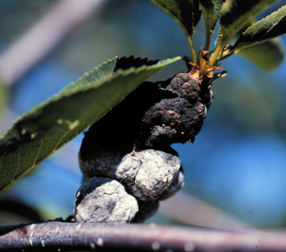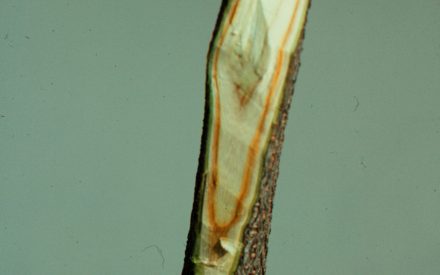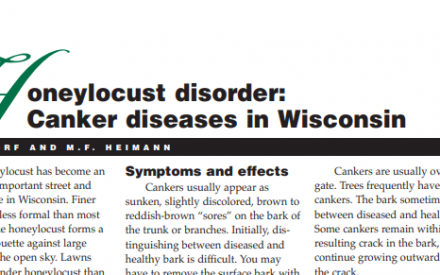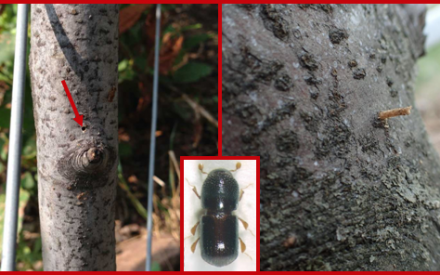
What is black knot?
Black knot is a disfiguring and potentially lethal disease of trees and shrubs in the genus Prunus. This genus includes stone fruits such as wild, fruit-bearing and ornamental plums and cherries.
What does black knot look like?
During the first year of infection, black knot-infected trees develop greenish-brown to brown swellings on affected branches and trunks. During the second year, these swellings enlarge into the ugly, black, erupting tumors (galls) characteristic of the disease. These galls resemble animal feces attached to branches (affectionately referred to as “poop-on-a-stick”). Older (greater than two years old) gall tissue often dies and then is colonized by fungi that give the gall a whitish or pinkish color. Severe black knot infections may cause general tree decline or death if galls girdle large limbs, or tree trunks.
Where does black knot come from?
Black knot is caused by the fungus Apiosporina morbosa, which survives in black knot galls on infected Prunus trees. Spores of the fungus are released from these galls and infect new branches in late spring or early summer during periods of wet weather and mild temperatures (55°F to 75°F).
How do I save a tree with black knot?
To manage existing black knot galls, simply remove the galls each winter from infected trees, then burn (where allowed by local ordinance) or bury them. Prune branches six to eight inches below each gall. On trunks, you can use a chisel to remove tissue from at least one inch beyond the infected area. Keep in mind however, that doing this creates a wound that can provide an entry point for other serious Prunus pathogens such as the bacteria that cause bacterial canker (see UW Plant Disease Facts D0009, Bacterial Canker). After removing galls, be sure to clean pruning tools between cuts by treating them for at least 30 seconds with 70% alcohol (e.g, rubbing alcohol or spray disinfectants) or a 10% bleach solution. This will prevent accidental movement of the black knot fungus from branch to branch, or from tree to tree as galls are removed. If you use bleach, be sure to thoroughly rinse your tools after you are done pruning and oil them to prevent rusting.
How do I avoid problems with black knot in the future?
In established plantings, remove any volunteer or wild cherry or plum trees from within 500 feet of susceptible fruit-bearing or ornamental cherries or plums. When purchasing new cherries and plums, carefully inspect trees prior to purchase to be sure they are free of black knot. When available, buy black knot-resistant ornamental cherry or plum species or varieties such as Prunus ‘Accolade’, Prunus sargentii, and Prunus maackii. DO NOT attempt to control this disease using fungicide treatments, as these treatments are expensive and not likely to be effective.
For more information on black knot:
Contact the University of Wisconsin Plant Disease Diagnostics Clinic (PDDC) at (608) 262-2863 or pddc@wisc.edu.
Authors: Brian Hudelson, UW-Madison Plant Pathology
Last Revised: 02/28/2024
D-number: D0018
Thanks to Patty McManus and Teryl Roper for reviewing this document.
A complete inventory of UW Plant Disease Facts is available at the University of Wisconsin-Madison Plant Disease Diagnostics Clinic website: https://pddc.wisc.edu.
Send a Plant Sample for Analysis
Be cautious when self-diagnosing plant health issues. Very few diseases can accurately be diagnosed by eye.
Contact the UW Plant Disease Diagnostics Clinic (PDDC), and for a small fee, clinic staff can examine a plant, determine the cause of the disease/disorder, and provide advice on how to control or prevent the issue.
Download Article





 Verticillium Wilt of Trees and Shrubs
Verticillium Wilt of Trees and Shrubs Honeylocust Disorder: Canker Diseases in Wisconsin
Honeylocust Disorder: Canker Diseases in Wisconsin Pruning Deciduous Trees
Pruning Deciduous Trees Black Stem Borer
Black Stem Borer


